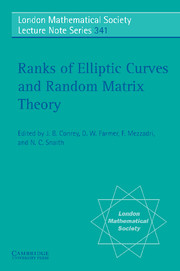Book contents
- Frontmatter
- Contents
- Introduction
- FAMILIES
- Elliptic curves, rank in families and random matrices
- Modeling families of L-functions
- Analytic number theory and ranks of elliptic curves
- The derivative of SO(2N +1) characteristic polynomials and rank 3 elliptic curves
- Function fields and random matrices
- Some applications of symmetric functions theory in random matrix theory
- RANKS OF QUADRATIC TWISTS
- NUMBER FIELDS AND HIGHER TWISTS
- SHIMURA CORRESPONDENCE, AND TWISTS
- GLOBAL STRUCTURE: SHA AND DESCENT
- Index
Function fields and random matrices
Published online by Cambridge University Press: 10 November 2010
- Frontmatter
- Contents
- Introduction
- FAMILIES
- Elliptic curves, rank in families and random matrices
- Modeling families of L-functions
- Analytic number theory and ranks of elliptic curves
- The derivative of SO(2N +1) characteristic polynomials and rank 3 elliptic curves
- Function fields and random matrices
- Some applications of symmetric functions theory in random matrix theory
- RANKS OF QUADRATIC TWISTS
- NUMBER FIELDS AND HIGHER TWISTS
- SHIMURA CORRESPONDENCE, AND TWISTS
- GLOBAL STRUCTURE: SHA AND DESCENT
- Index
Summary
… le mathématicien qui étudie ces problèmes a l'impression de déchiffrer une inscription trilingue. Dans la première colonne se trouve la théorie riemannienne des fonctions algébriques au sens classique. La troisième colonne, c'est la théorie arithmétique des nombres algébriques. La colonne du milieu est celle dont la découverte est la plus récente; elle contient la théorie des fonctions algébriques sur un corps de Galois. Ces textes sont l'unique source de nos connaissances sur les langues dans lesquels ils sont écrits; de chaque colonne, nous n'avons bien entendu que des fragments; …. Nous savons qu'il y a des grandes différences de sens d'une colonne à l'autre, mais rien ne nous en avertit à l'avance.
A. Weil, “De la métaphysique aux mathématiques” (1960)The goal of this survey is to give some insight into how well-distributed sets of matrices in classical groups arise from families of L-functions in the context of the middle column of Weil's trilingual inscription, namely function fields of curves over finite fields. The exposition is informal and no proofs are given; rather, our aim is to illustrate what is true by considering key examples.
In the first section, we give the basic definitions and examples of function fields over finite fields and the connection with algebraic curves over function fields. The language is a throwback to Weil's Foundations, which is quite out of fashion but which gives good insight with a minimum of baggage.
Information
- Type
- Chapter
- Information
- Ranks of Elliptic Curves and Random Matrix Theory , pp. 109 - 142Publisher: Cambridge University PressPrint publication year: 2007
